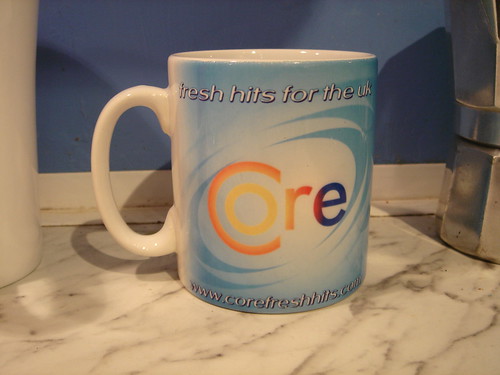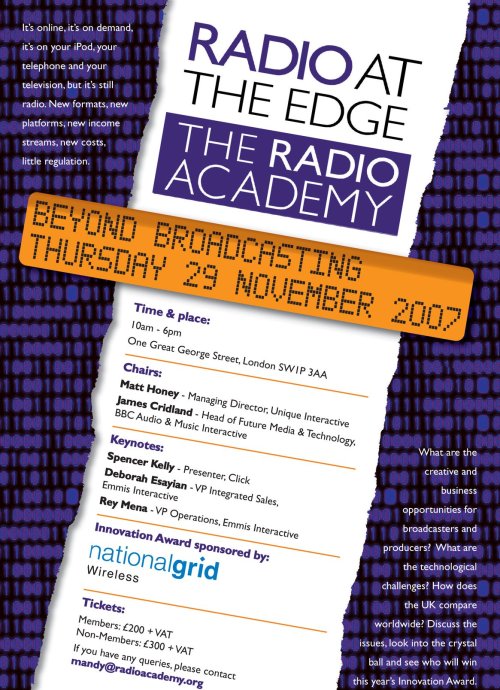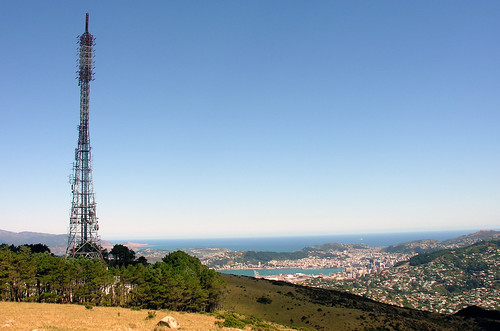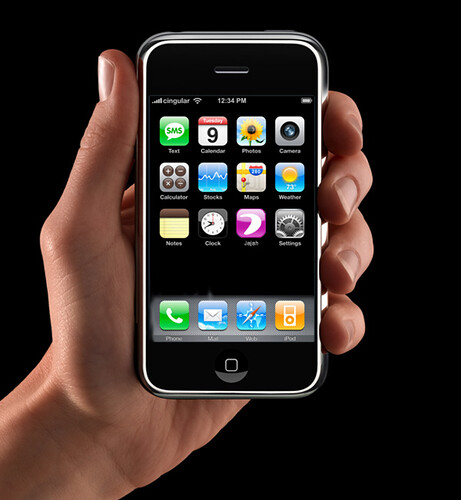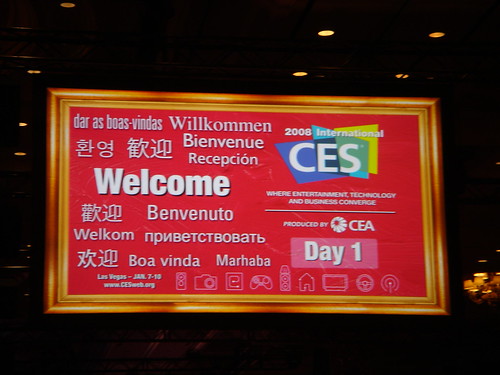
I was lucky enough to visit The Consumer Electronics Show this year. CES lies at the very heart of the consumer electronics industry, and is a bellwether for the health of consumer spending and consumer interests. I went to go and see how radio fits into this frenetic and fast-moving world.
CES is vast. Truly awe-inspiringly vast. 140,000 delegates, thousands and thousands exhibitors, spread across tens of thousands of hall space across three huge venues. I mean, you may think it’s a long way down the road to the chemist, but that’s just peanuts to CES. (with apologies to Douglas Adams). Your chances of seeing it all are slimmer than a whelks chance in a supernova (ditto). But one does ones very best, and wears comfortable shoes (the very best tip I got from reading the blogosphere)
CES has the whole spectrum of consumer electronics providers – from the powerhouses of Samsung, LG, Microsoft, Intel, Motorola, Panasonic – to hundreds and hundreds of booths in a shanty town like arrangement representing the manufacturing communities of China and Taiwan.
Bill Gates (Microsoft) and Paul Otellini (Intel) both devoted large segments of their Keynote speeches to the future of Digital Entertainment (and a quick bash on Guitar Hero for Bill, and a bloke called Slash). Sweeping presentations and brilliant visuals emphasised a seamless entertainment experience in the home, the car and the mobile device. TV – yep. Films – you got ’em. Music – sure thing. Radio… Hello, hello, paging radio – is radio in the house? Apparently not. Oh well. (Otellini’s speech started with a reworking of The Buggles, Video Killed The Radio Star which rather fell over when people realised that video hasn’t actually killed the radio star – but hey, it was a great 80’s start to the show).
So where was radio amongst the vast shiny stands of the world’s major consumer electronics brands. Not present. Largely, I guess, because radio isn’t cutting edge techsexy. (Although I’ve no idea what LG were thinking of when inventing Mobile Pedestrian Handheld “MPH”, and attempting another flogging session of the dead horse of mobile TV). Does Microsoft’s Mediaroom (their IPTV platform) support radio; well, they weren’t sure, but it does do music. How about Microsoft Media Center (sic) – same response. Slightly better news at the Zune stand, where they recognised that lack of streaming support was a bit of a negative, and said there was a roadplan.
Nokia was good. They were demonstrating streaming radio on the N95 and Capital 95.8 streamed faultlessly first time. They talked about bringing together the Visual Radio and Streaming Radio into a single client, which is an exciting prospect. And they really joined in with the enviro/green theme of the show (which must have had a dedicated, and doubtless coal-fired, power plant. Amusingly the local coal lobby was running adverts on the local radio stations about how important and how much cleaner coal was nowadays. Yeah, yeah).
Most of the brand MP3 players have FM radio chucked in as an afterthought. It adds headcount, but nothing very exciting or revolutionary for the radio industry. iRiver were the notable exception, demoing their excellent little B20 device (which has the most comprehensive DAB Digital Radio implementation ever seen, on any device, anywhere) alongside their new W7 and W10 wifi enabled devices. Cowon also demo’ed a MP3+DAB radio unit. But where are Creative, Apple?
So, what about WiMax – to some people, the solution for broadcast radio to the masses? XOHM is the US implementation of WiMax, and they had a great theme driven stand. I asked which theme radio fitted into, and they thought it would probably be the “in the car” theme. But the “in the car” team hadn’t thought about radio. They thought it probably would work because mobile TV works over WiMax, but they promised to have a think about it and get back to me. Seems like the admiration between radio and WiMax isn’t mutual.
So far, the picture looks a bit glum. In a show driven by innovation in consumer electronics, there’s not much radio brings to the party. But let’s go deeper, and talk to the people on the stands.
Most the product managers I was able to talk to were quite interested in the idea of a new kind of radio. In essence, they were saying – give us something new to talk about, and we’ll include it. Logitech and Sonus talked about how their streaming devices can support visualisation, extended information, and interactivity – but no radio station has ever come and asked them about it. I spent some time with the folks from HD Radio, and they talked about how well the iTunes Tagging concept had been received, and demo’ed their natty media player device. Sirius and XM both had impressive stands showing of their range of own brand devices. Radio can do innovation, but apparently only when it’s done by new entrants; it would seem that legacy businesses find it awfully hard to get their heads round anything other than today and yesterday.
The other astonishing hit of the show, in terms of ubiquity, was Digital Picture Frames. They were simply everywhere, despite being described by one wag as “21st Century Lava Lamps”. I predict that an awful lot of homes will have them, and the manufacturers are already trying to differentiate themselves. Some have WiFi, some have Bluetooth, some play MP3s to accompany the pictures. But hang on, if it can play MP3, why not DAB digital radio? Isn’t the Kitchen Radio of the future actually a nifty 7″ digital picture frame, that shows Slideshow when you’re listening to the radio, and shows your favourite pictures when you’re not. Why, hey – now there’s an opportunity. (And a new Slideshow spec will be out shortly).
I was really pleased to be able to meet Jack Schofield of The Guardian in Vegas. We literally bumped into each other on the strip, and used the opportunity to have a really good discussion about DAB Digital Radio. Readers of both our outputs know that my responses have been tart at times, but I hope that the time we spent having an interesting and wide-ranging chat affirms with Jack that there’s no personal animosity, and that everyone on the Digital Radio project has a real passion for radio and that we do the very best we can with the resources and freedoms we have.
One final observation, and this is more to do with radio programming than digital radio. Vegas is the home of the 80’s pop hit. Music is piped everywhere – streets, lobbies, casino floors, restaurants, lifts. Not once, and I mean not one single time in a 6 day stay, did I hear anything other than pop hits from the 1980’s. Nu Shooz, I Can’t Wait; Falco, Der Kommisar; El Debarge, Who’s Johnny…. Given that Vegas is a multi-million dollar industry that is heavily researched, I believe that 80’s pop hits must make people happy, must make people spend lots of money, and therefore must be the sleeper hit format for digital radio in 2008.
There’s a flickr stream of my CES photos here.
Nick travelled with bmi from Manchester to Vegas, who were lovely, even if they caught a 5 hour delay on the way back. You have to love a British airline that serves clotted cream tea, cornish pasties and cottage pie, and brings the tea round before the coffee.


